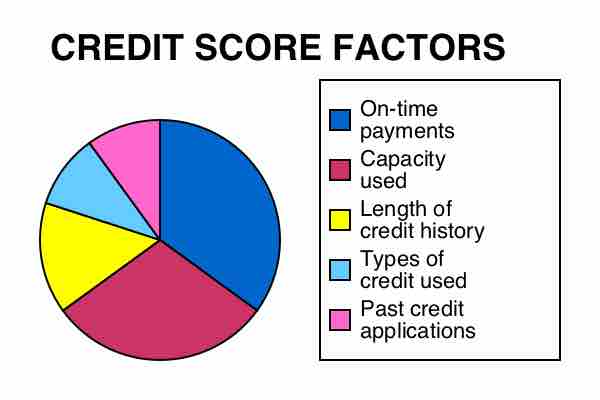Setting a Credit Policy
There are three steps a company must undergo when developing a credit policy:
- Establish credit standards.
- Establish credit terms.
- Establish a collection policy.
Management must decide on credit standards, which involves decisions on how much credit risk to assume. These decisions play a large role in determining how much money a firm ties up in its receivables. A restrictive policy will most likely result in lower sales, but the firm will have a smaller investment in receivables and incur less bad-debt losses. Less restrictive policies will generate higher sales as well as a higher receivables balance, but the company will most likely incur more bad-debt losses and a high opportunity cost of holding capital in accounts receivables.

Credit Score Factors
This chart depicts the factors that go into an individual's credit score.
Another important factor in determining credit standards involves a company evaluating the credit worthiness, or credit score, of an individual or business. This refers to the risk that the buyer will default on extended credit by failing to make payments which it is obligated to do. Potential losses not only include the selling price, but can also include disruption to cash flows and increased collection costs. To reduce its risk, the seller may perform a credit check on the buyer or require the buyer to put up collateral against credit extended.
Other Facets of Credit Policies
After establishing credit standards, the firm must decide on the length of the period that would be allowed before payment must be made and whether or not they will offer a discount for early payments. If a discount is offered, the amount of the discount must also be determined. There are many purposes for discounting, such as to move out-of-date stock, to reward valuable customers, as a sales promotion, or to reward behaviors that benefit the discount issuer. Some common types of discounts include:
- Prompt payment discount.
- Preferred payment discount (such as cash over credit card).
- Partial payment discount.
- Seasonal discount (for orders placed in a slack period for example).
- Trade discount (usually given when the buyer agrees to perform some function).
- Quantity discount.
The last step is to establish a collection policy. Collection policies vary widely among industries. Some companies do nothing when their customers don't pay. Others send out a reminder notifying customers that their payment is late. Some companies may even take legal action at the first late payment.
The Five C's Of Credit
- Character: Is the borrower trustworthy with a history of meeting its debt obligations?
- Capacity: Will the borrower have enough cash flow to make its payments?
- Capital: Does the borrower have enough capital to justify the loan?
- Collateral: Does the borrower have any assets that can secure the loan?
- Conditions: How are both the borrower and the economy performing and how are they expected to perform?